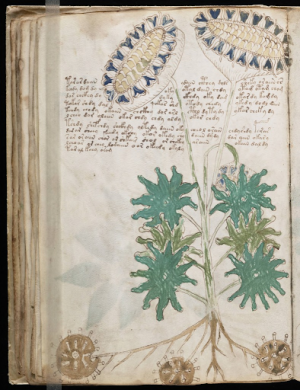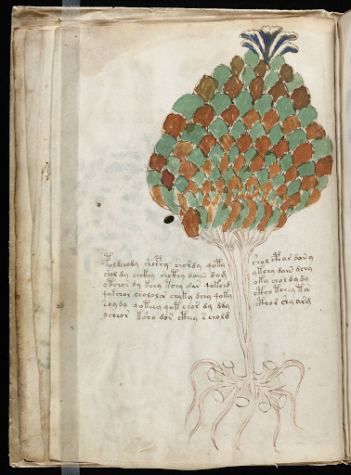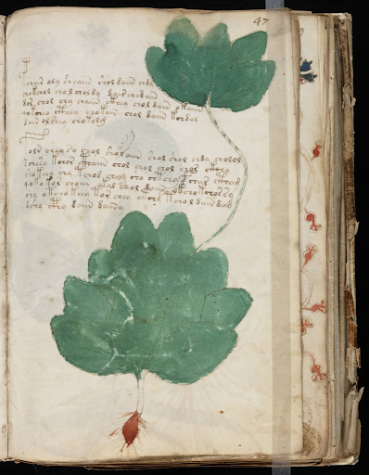Mysteries, Oddities, and Everything Strange: Voynich Manuscript
June 1, 2023
Voynich Manuscript: Important Gibberish
Languages have taken on many different evolutions and changes throughout history. Ancient languages like Latin have helped paved the way for modern-day tongues like English and Spanish. Different alphabets and symbols indicate different sounds and pronunciations, accent marks and tildes alike have altered pre-existing intonation patterns, and plenty of other changes have brought the state of the world’s languages to where they are today. But some ancient passages have yet to be deciphered, as their dissimilarity from modern structures makes them almost complete gibberish to modern-day humans. One such example of this unpredictable language, the Voynich Manuscript, provides a glimpse into life hundreds of years ago—if it can be translated.
 In 1912, Wilfred Voynich, the manuscript’s namesake, discovered the text through his usual practice of rare book dealing. Despite this modern uncovering, the book had frequently floated through history, reportedly being present at the library of Rudolf II, emperor of the Holy Roman Empire, and cycled through rare book sales at the Society of Jesus in Rome. The book also contains plenty of interesting illustrations, from weird plants to unrecognizable planetary bodies. The book was likely created in Europe around the early 1400s, but the actual date of creation is both hotly debated and practically possible to determine.
In 1912, Wilfred Voynich, the manuscript’s namesake, discovered the text through his usual practice of rare book dealing. Despite this modern uncovering, the book had frequently floated through history, reportedly being present at the library of Rudolf II, emperor of the Holy Roman Empire, and cycled through rare book sales at the Society of Jesus in Rome. The book also contains plenty of interesting illustrations, from weird plants to unrecognizable planetary bodies. The book was likely created in Europe around the early 1400s, but the actual date of creation is both hotly debated and practically possible to determine.
The book was first documented to be in the presence of an astronomer named John Dee before being passed off to Rudolf II of Germany (also known as the Holy Roman Emperor). It was thought to be from the penmanship of Roger Bacon, an English philosopher from the 13th century. Jacobus Horcicky de Tepenecz was the next recipient of the manuscript, and it continued to pass through owners in Europe before finding itself at the rare book section of Yale University’s library.
 The book’s purpose and subject matter have been subjects of controversy when considering its translation. The possibility of the book being related to botany, astronomy, astrology, biology, medicine, cosmology, pharmacology, and recipes. The illustrations within its pages have also been called into question, especially the plants and humanoid figures. The flora appears to have a combination of features from other plant species and even animals or humans, with one illustration sprouting not one but two human heads. The people in the script are whimsical in quality and have interesting features that were an oddity for the time period.
The book’s purpose and subject matter have been subjects of controversy when considering its translation. The possibility of the book being related to botany, astronomy, astrology, biology, medicine, cosmology, pharmacology, and recipes. The illustrations within its pages have also been called into question, especially the plants and humanoid figures. The flora appears to have a combination of features from other plant species and even animals or humans, with one illustration sprouting not one but two human heads. The people in the script are whimsical in quality and have interesting features that were an oddity for the time period.
The alphabet that the book consists of is nothing like any documented languages or structures. The language is very fluid, with many letters being connected or possessing loops and fancy features. What the symbols represent is almost entirely unclear, as they could be pointing towards letters, sounds, numbers, values, or other possible representations. Hundreds of people have attempted to decipher what exactly the book means, and some have even claimed to have completely solved it, but nothing has proved entirely successful and most of the manuscript remains shrouded in mystery.
 Despite this, one method has brought humanity closer to fully understanding what is occurring in this passage: the internet. The collective knowledge and resources of everyone who has access to forums and chat threads can pool their potential theories and grow closer to cracking the code of the mysterious pages. Many people, including historians, locksmiths, and computer programmers have put forth their ideas surrounding what the book could possibly mean, and so far, there has been more progress made through these methods than there has been for hundreds of years.
Despite this, one method has brought humanity closer to fully understanding what is occurring in this passage: the internet. The collective knowledge and resources of everyone who has access to forums and chat threads can pool their potential theories and grow closer to cracking the code of the mysterious pages. Many people, including historians, locksmiths, and computer programmers have put forth their ideas surrounding what the book could possibly mean, and so far, there has been more progress made through these methods than there has been for hundreds of years.
The possibility that this manuscript is nothing more than a hoax is entirely possible, but the threshold for its tomfoolery must have been enormous. The person who crafted this piece of literature must be talented in linguistics and art, as well as a good ability to spread this information and plenty of time to dedicate to its creation. This person would have existed in the 15th century or earlier, and pranksters of the time definitely had the potential to create a joke such as this. It might invalidate hundreds of years of work, but this possibility, like many weird things in human history, is entirely possible.
The Voynich Manuscript might never be entirely deciphered or understood, but the impact it has left on the history of code-breaking and linguistics will never be forgotten. Its purpose could be for botany or hijinks, but nevertheless, it has left an impact on the history of literature and could be a key puzzle piece in understanding culture that had been almost entirely lost to history.
Resources:
https://en.wikipedia.org/wiki/Voynich_manuscript
https://beinecke.library.yale.edu/collections/highlights/voynich-manuscript
https://www.newyorker.com/books/page-turner/the-unread-the-mystery-of-the-voynich-manuscript





















































